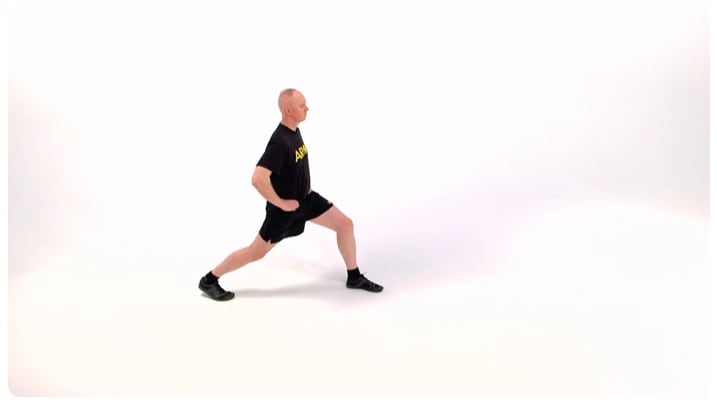The rear lunge exercises, commonly referred to as the reverse lunges, are foundational leg exercises incorporated into many workout regimes.
- Offering a plethora of benefits, it’s hailed as a modification to the traditional forward lunge with a focus on stability and unilateral leg strength.
This exercise not only helps in building muscle but also improves balance and coordination, making it a vital component in many fitness routines.
Table of Contents
show
Army Recovery Drill Rear Lunges

The rear lunge is the second exercise in the recovery drill.
- This particular exercise is essential for promoting flexibility in the hip, enhancing leg strength, and aiding balance.
- Moreover, it adeptly prepares the soldier for swift movements like taking cover, getting into kneeling and firing positions.
- This exercise develops the flexibility of the hip flexors and trunk muscles.
Starting Position:
- Straddle stance, hands on hips.
Position 1:
- Command: “Ready, STRETCH.”
- Action: Take an exaggerated step backward with the left leg, touching down with the ball of the foot.
- This mirrors count 1 of the rear lunge in the preparation drill.
- Duration: Hold this position for 20-30 seconds.
Transition to the Starting Position:
- Command: “Starting Position, MOVE.”
- Action: Assume the starting position.
Position 2:
- Command: “Change Position, Ready, STRETCH.”
- Action: Take an exaggerated step backward with the right leg, touching down with the ball of the foot.
- This is the same as count 3 of the rear lunge in the PD.
- Duration: Hold this position for 20-30 seconds.
Return to the starting position:
- Command: “Starting Position, MOVE.”
- Action: Return to the starting position.
Check Points:
- Back Alignment: Maintain straightness by keeping the abdominal muscles tight throughout.
- Motion Post-foot Touch: After the foot touches down on positions 1 and 2, continue to lower the body.
- Lunge Direction: Lunge and step in a straight line, ensuring feet are directed forward.
- Foot Alignment: From the front, feet should be shoulder-width apart, both at the start and end of positions 1 and 2.
- Forward Knee Position: Keep over the ball of the foot in positions 1 and 2.
- Rear Foot Position: Ensure the heel doesn’t touch the ground.
Precaution:
- While lunging left or right, ensure the knee doesn’t move forward of the toes.
Reverse Lunge Benefits:
- Stability & Balance: This exercise challenges and improves your balance and core stability.
- Enhanced Leg Strength & Power: Regularly incorporating reverse lunges can lead to increased leg strength.
- Flexibility & Range of Motion: A deep lunge increases hip flexibility and promotes a greater range of motion.
- Decreased Strain: Compared to forward lunges, the reverse movement decreases strain on the knees.
- Functional Movement: This movement replicates natural motions, making it essential for athletes and daily activities.
Muscles Worked by Reverse Lunges
| Muscle Group | Function in Reverse Lunge Exercises |
|---|---|
| Quadriceps | Engaged when stepping backward and returning to start. |
| Hamstrings | Worked as you pushed back up from the lunge. |
| Glutes | Activated when lowering into the lunge and pushing back up. |
| Calves | Stabilize the movement, engaged when pushing back to start. |
| Core Muscles | Engaged throughout for stability and balance. |
Reverse Lunges Training Tips:
- Form First: Always prioritize maintaining correct posture throughout the movement.
- 90-Degree Rule: Aim to achieve both knees at approximately a 90-degree angle at the deepest part of the lunge.
- Avoid Knee Overextension: Make sure your forward knee doesn’t extend past your toes to avoid undue strain.
- Mind the Step: Ensure you take a wide enough step back to maintain form and balance.
- Engage Your Core: Keep your abdominal muscles tight and engaged for stability throughout the movement.
Maximizing the Reverse Lunge Exercise
To derive the most benefit from the reverse lunge, consider adding variations or combining it with other movements:
- Weighted Rear Lunges: Increase resistance by holding dumbbells or a barbell.
- Lunge Pulses: Add a pulsing motion at the bottom of the lunge to increase intensity.
- Walking Reverse Lunges: Incorporate movement by lunging in a walking motion.
- Combine with Other Movements: For a compound exercise, add a twist or a push-up between lunges.
Rear Lunges Conclusion
The rear lunge is an adaptable exercise suitable for individuals at various fitness levels.
- Whether you’re a beginner looking to master basic movements or an advanced athlete seeking functional training, the reverse lunge is both versatile and effective.
- Incorporating it into your routine can pave the way for stronger legs and better athletic performance.
Latest posts by George N. (see all)
- Empowering Transactions: Navigating Firearms Sales with Proper Documentation - April 8, 2024
- Army PRT – Preparation and Recovery 2024 - March 18, 2024
- Active and Reserve Components 2024 - March 6, 2024

